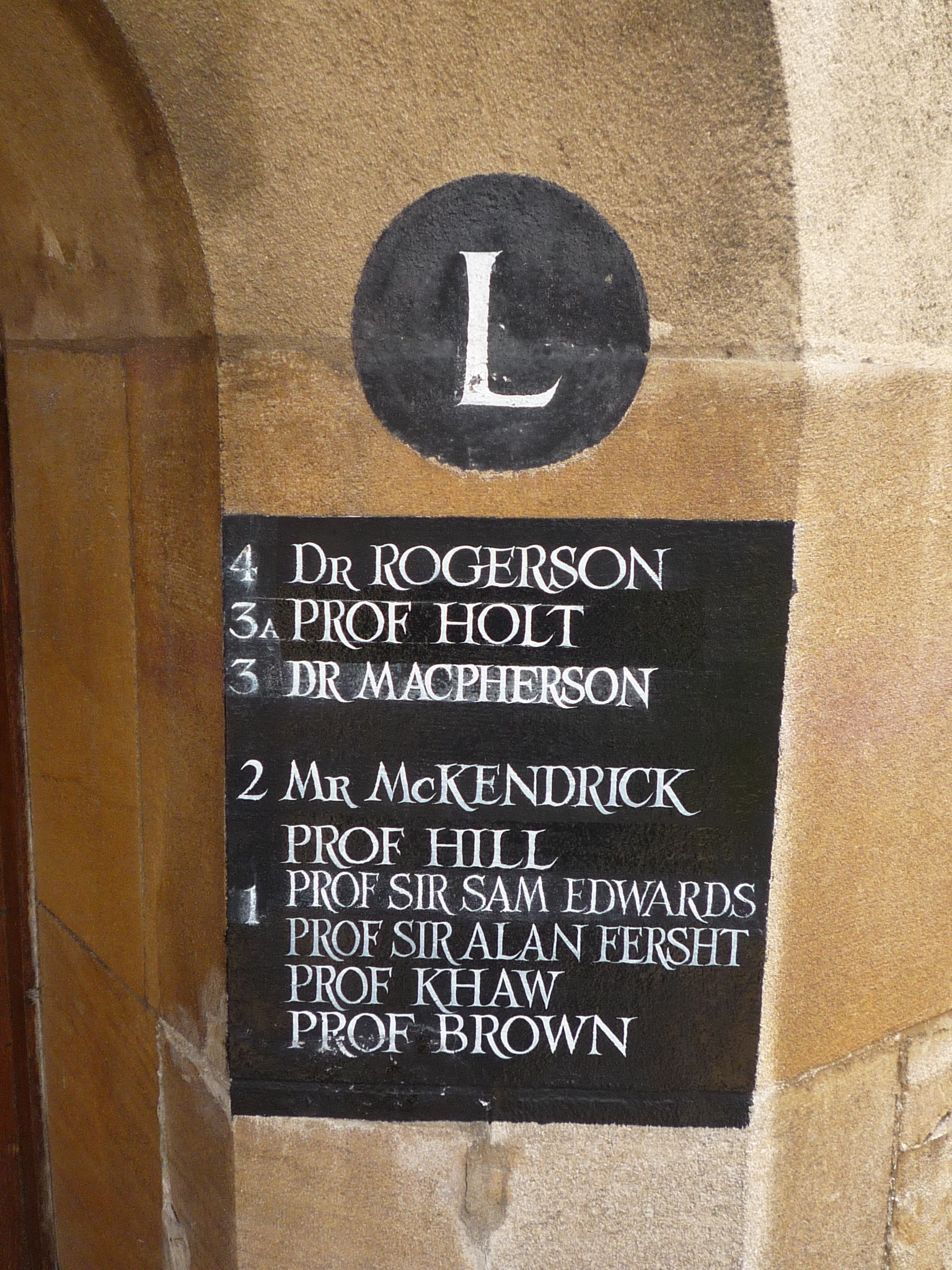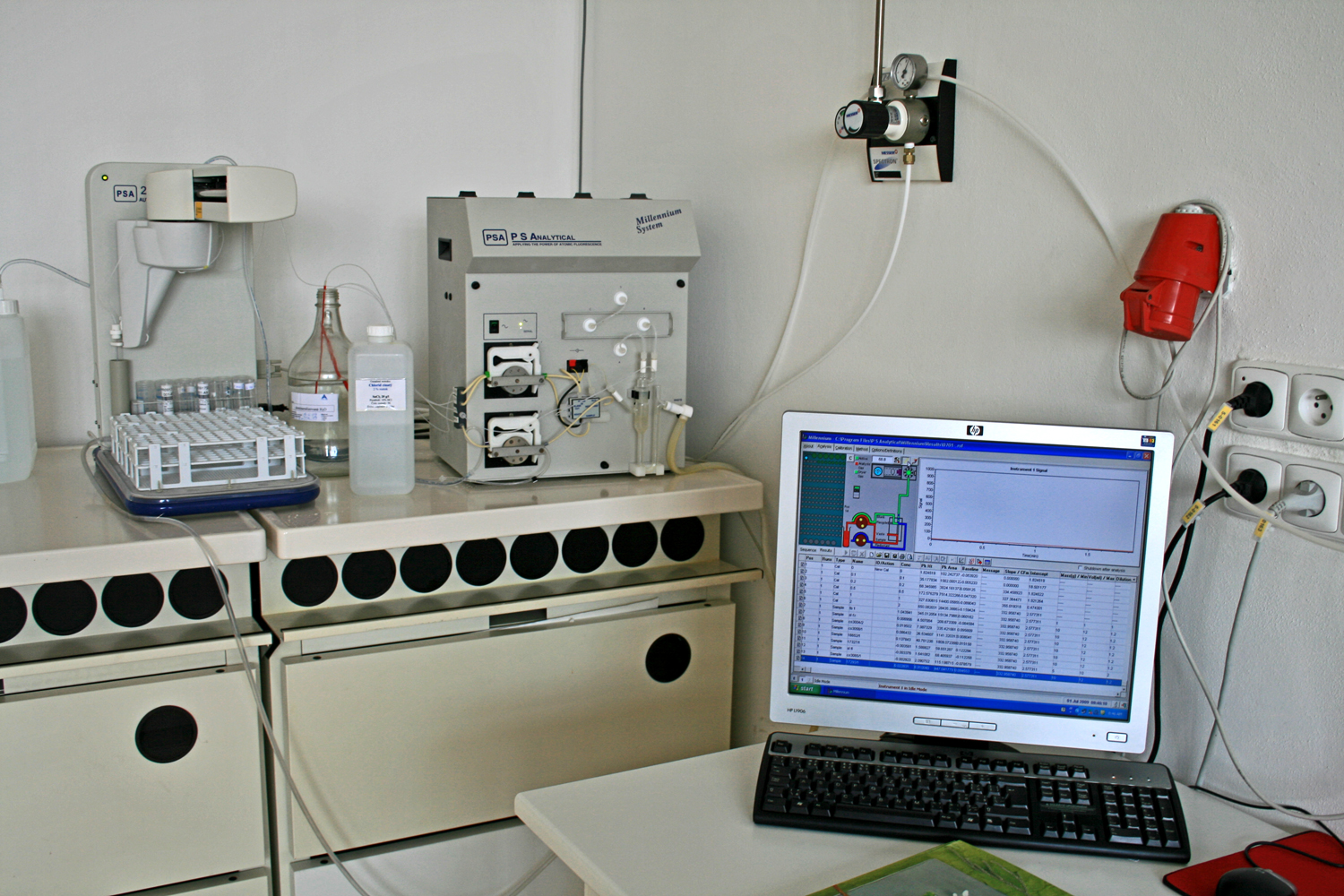|
Stopped-flow
Stopped-flow is an experimental technique for studying chemical reactions with a half time of the order of 1 ms, introduced by Britton Chance and extended by Quentin Gibson (Other techniques, such as the temperature-jump method, are available for much faster processes.) Description of the method Summary Stopped-flow spectrometry allows chemical kinetics of fast reactions (with half times of the order of milliseconds) to be studied in solution. It was first especially used to enzyme-catalyzed reactions. Then the stopped-flow rapidly found its place in almost all biochemistry, biophysics, and chemistry laboratories with a need to follow chemical reactions in the millisecond time scale. In its simplest form, a stopped-flow mixes two solutions. Small volumes of solutions are rapidly and continuously driven into a high-efficiency mixer. This mixing process then initiates an extremely fast reaction. The newly mixed solution travels to the observation cell and pushes out the contents o ... [...More Info...] [...Related Items...] OR: [Wikipedia] [Google] [Baidu] |
Britton Chance
Britton "Brit" Chance (July 24, 1913 – November 16, 2010) was an American biochemist, biophysicist, scholar, and inventor whose work helped develop spectroscopy as a way to diagnose medical problems. He was "a world leader in transforming theoretical science into useful biomedical and clinical applications" and is considered "the founder of the biomedical photonics." He received the National Medal of Science in 1974. He also was an Olympic athlete who won a gold medal for the United States at the 1952 Summer Olympics in the 5.5 Metre Class. Early life and education Chance was born in Wilkes-Barre, Pennsylvania. His parents were Eleanor Kent and Edwin Mickley Chance, president of United Engineers and Constructors, Inc which built power plants. His father was also a mining engineer, chemist, and inventor who held a number of metallurgical patents and created a device that detected carbon monoxide in coal mines using a chemical reaction. Chance's paternal grandfather, Henry M ... [...More Info...] [...Related Items...] OR: [Wikipedia] [Google] [Baidu] |
Alan Fersht
Sir Alan Roy Fersht (born 21 April 1943) is a British chemist at the MRC Laboratory of Molecular Biology, Cambridge, and an Emeritus Professor in the Department of Chemistry at the University of Cambridge. He was Master of Gonville and Caius College, Cambridge from 2012 to 2018. He works on protein folding, and is sometimes described as a founder of protein engineering. Early life and education Fersht was born on 21 April 1943 in Hackney, London. His father, Philip, was a ladies' tailor and his mother, Betty, a dressmaker. His grandparents were Jewish immigrants from Poland, Romania, Lithuania and Belarus. He was educated at Sir George Monoux Grammar School, an all-boys grammar school in Walthamstow, London. He was a keen chess player and was the Essex County Junior champion in 1961. He was awarded a State Scholarship to read Natural Sciences at Gonville and Caius College, Cambridge, where he obtained First Class in Pt I of the Natural Sciences Tripos in 1964, First Class i ... [...More Info...] [...Related Items...] OR: [Wikipedia] [Google] [Baidu] |
Comparison Of Stopped Flow With Quenched Flow
Comparison or comparing is the act of evaluating two or more things by determining the relevant, comparable characteristics of each thing, and then determining which characteristics of each are similar to the other, which are different, and to what degree. Where characteristics are different, the differences may then be evaluated to determine which thing is best suited for a particular purpose. The description of similarities and differences found between the two things is also called a comparison. Comparison can take many distinct forms, varying by field: To compare things, they must have characteristics that are similar enough in relevant ways to merit comparison. If two things are too different to compare in a useful way, an attempt to compare them is colloquially referred to in English as "comparing apples and oranges." Comparison is widely used in society, in science and in the arts. General usage Comparison is a natural activity, which even animals engage in when deci ... [...More Info...] [...Related Items...] OR: [Wikipedia] [Google] [Baidu] |
Quenched Flow Method For Fast Reactions
In materials science, quenching is the rapid cooling of a workpiece in water, oil, polymer, air, or other fluids to obtain certain material properties. A type of heat treating, quenching prevents undesired low-temperature processes, such as phase transformations, from occurring. It does this by reducing the window of time during which these undesired reactions are both thermodynamically favorable, and kinetically accessible; for instance, quenching can reduce the crystal grain size of both metallic and plastic materials, increasing their hardness. In metallurgy, quenching is most commonly used to harden steel by inducing a martensite transformation, where the steel must be rapidly cooled through its eutectoid point, the temperature at which austenite becomes unstable. In steel alloyed with metals such as nickel and manganese, the eutectoid temperature becomes much lower, but the kinetic barriers to phase transformation remain the same. This allows quenching to start at a lower ... [...More Info...] [...Related Items...] OR: [Wikipedia] [Google] [Baidu] |
Francis John Worsley Roughton
Francis John Worsley Roughton (6 June 1899 – 26 April 1972) was an English physiologist and biochemist. He began to conduct experiments to study the reactions involving haemoglobin and oxygen and went on to make pioneering studies of blood biochemistry and gas interaction kinetics. Along with Hamilton Hartridge, he developed continuous monitoring approaches to study liquid-gas binding reactions and enzyme kinetics. Roughton was born in Kettering and came from a family of physicians. Born with congenital tachycardia he went to study science at Winchester and Cambridge. Because of his heart condition he was not recruited into World War I. At Cambridge he decided not to follow the family line and began to study physiology after being influenced by Joseph Barcroft Sir Joseph Barcroft (26 July 1872 – 21 March 1947) was a British physiologist best known for his studies of the oxygenation of blood. Life Born in Newry, County Down into a Quaker family, he was the son of Henry Ba ... [...More Info...] [...Related Items...] OR: [Wikipedia] [Google] [Baidu] |
Hamilton Hartridge
Hamilton Hartridge (7 May 1886 – 13 January 1976) was a British eye physiologist and medical writer.'Obituary: H. Hartridge', ''British Medical Journal'', 20 March 1976, p.716 Known for his ingenious experimentation and instrument construction abilities, he designed what is called the Hartridge Reversion Spectrometer. This was used for pioneering studies on haemoglobin oxygen-binding studies. Hamilton Hartridge FRS was educated at Harrow and King's College, Cambridge, where he became a fellow from 1912 to 1926. He graduated in medicine from St George's Hospital in 1914, serving during the war as an experimental officer at RNAS Kingsnorth. In 1916 he married Kathleen Wilson. After the war he stayed in Cambridge University as lecturer in special senses and senior demonstrator in physiology. He gained a reputation as an ingenious experimenter, constructing, for example, the continuous-flow apparatus for measuring the rates of very fast reactions, as well as working to revise esta ... [...More Info...] [...Related Items...] OR: [Wikipedia] [Google] [Baidu] |
Diagram Of Continuous Flow
A diagram is a symbolic representation of information using visualization techniques. Diagrams have been used since prehistoric times on walls of caves, but became more prevalent during the Enlightenment. Sometimes, the technique uses a three-dimensional visualization which is then projected onto a two-dimensional surface. The word ''graph'' is sometimes used as a synonym for diagram. Overview The term "diagram" in its commonly used sense can have a general or specific meaning: * ''visual information device'' : Like the term "illustration", "diagram" is used as a collective term standing for the whole class of technical genres, including graphs, technical drawings and tables. * ''specific kind of visual display'' : This is the genre that shows qualitative data with shapes that are connected by lines, arrows, or other visual links. In science the term is used in both ways. For example, Anderson (1997) stated more generally: "diagrams are pictorial, yet abstract, representat ... [...More Info...] [...Related Items...] OR: [Wikipedia] [Google] [Baidu] |
Light Scattering
Scattering is a term used in physics to describe a wide range of physical processes where moving particles or radiation of some form, such as light or sound, are forced to deviate from a straight trajectory by localized non-uniformities (including particles and radiation) in the medium through which they pass. In conventional use, this also includes deviation of reflected radiation from the angle predicted by the law of reflection. Reflections of radiation that undergo scattering are often called ''diffuse reflections'' and unscattered reflections are called ''specular'' (mirror-like) reflections. Originally, the term was confined to light scattering (going back at least as far as Isaac Newton in the 17th century). As more "ray"-like phenomena were discovered, the idea of scattering was extended to them, so that William Herschel could refer to the scattering of "heat rays" (not then recognized as electromagnetic in nature) in 1800. John Tyndall, a pioneer in light scattering resear ... [...More Info...] [...Related Items...] OR: [Wikipedia] [Google] [Baidu] |
Fluorescence Spectroscopy
Fluorescence spectroscopy (also known as fluorimetry or spectrofluorometry) is a type of electromagnetic spectroscopy that analyzes fluorescence from a sample. It involves using a beam of light, usually ultraviolet light, that excites the electrons in molecules of certain compounds and causes them to emit light; typically, but not necessarily, visible light. A complementary technique is absorption spectroscopy. In the special case of single molecule fluorescence spectroscopy, intensity fluctuations from the emitted light are measured from either single fluorophores, or pairs of fluorophores. Devices that measure fluorescence are called fluorometers. Theory Molecules have various states referred to as energy levels. Fluorescence spectroscopy is primarily concerned with electronic and vibrational states. Generally, the species being examined has a ground electronic state (a low energy state) of interest, and an excited electronic state of higher energy. Within each of these elec ... [...More Info...] [...Related Items...] OR: [Wikipedia] [Google] [Baidu] |
Quentin Gibson
Quentin Howieson Gibson FRS (9 December 1918 – 16 March 2011) was a Scottish American physiologist, and professor at University of Sheffield, and Cornell University. Education Gibson earned a Doctor of Medicine degree in 1944 and a Ph.D. in 1946, from Queen's University Belfast. Life Gibson taught at the University of Sheffield from 1947. Whilst at the University of Sheffield Gibson met Audrey Jane Pinsent in 1951. They married, started a family, and eventually had four children. Jane Gibson continued working part-time whilst raising her family. In 1963 they emigrated to the United States, where she took up positions, first at the University of Pennsylvania. He succeeded (Sir) Hans Krebs as the Head of the Department of Biochemistry in 1955. In 1963 he left Sheffield to become a professor at the University of Pennsylvania. He was the Greater Philadelphia Professor at Cornell University, from 1965 to 1996. In 1982, he became a U.S. citizen. Research Hemoglobin Gibson started ... [...More Info...] [...Related Items...] OR: [Wikipedia] [Google] [Baidu] |
Ultraviolet Spectroscopy
Ultraviolet (UV) is a form of electromagnetic radiation with wavelength from 10 nm (with a corresponding frequency around 30 PHz) to 400 nm (750 THz), shorter than that of visible light, but longer than X-rays. UV radiation is present in sunlight, and constitutes about 10% of the total electromagnetic radiation output from the Sun. It is also produced by electric arcs and specialized lights, such as mercury-vapor lamps, tanning lamps, and black lights. Although long-wavelength ultraviolet is not considered an ionizing radiation because its photons lack the energy to ionize atoms, it can cause chemical reactions and causes many substances to glow or fluoresce. Consequently, the chemical and biological effects of UV are greater than simple heating effects, and many practical applications of UV radiation derive from its interactions with organic molecules. Short-wave ultraviolet light damages DNA and sterilizes surfaces with which it comes into contact. For huma ... [...More Info...] [...Related Items...] OR: [Wikipedia] [Google] [Baidu] |



